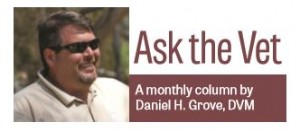 Foaling season is upon us. Foals are dropping left and right. From 12 to 24 hours after birth, it is an excellent idea to have your newborn evaluated by your veterinarian. This month, I would like to discuss what I do on my new foal exams and why. I do them in the same order every time so that I do not miss anything. I start at the tail and work my way forward.
Foaling season is upon us. Foals are dropping left and right. From 12 to 24 hours after birth, it is an excellent idea to have your newborn evaluated by your veterinarian. This month, I would like to discuss what I do on my new foal exams and why. I do them in the same order every time so that I do not miss anything. I start at the tail and work my way forward.
Genitalia — The first area I start with. I determine the sex of the foal and examine the external genitalia to make sure things are normal. Does the vulva appear normal if it is a filly? And on the males, are both testes down?
Tetanus Antitoxin — While I am at the tail, I give a dose of tetanus antitoxin. Regardless of the fact the mare should have been vaccinated properly before foaling and passed on passive immunity to the foal, it is cheap insurance against a very challenging disease to treat.
Umbilicus — Next I move to the belly button area. I make sure the umbilical stump appears and palpates normally. Also we check for an umbilical hernia. Finally, a good dipping of the stump in some chlorhexadine solution is great to prevent infections down the road.
Heart and lungs — I now move forward and listen to the heart and lungs. In the heart, I want to hear a good lub-and-dub — and no extra sounds. There is a small valve in the heart that is supposed to close just after birth and we can usually pick up on it at this time if it did not. In the lungs, we want nice clean lung sounds with little to no moisture. Also, we want to listen for abrupt loud noises that could indicate a fractured rib.
Eyes — With the eyes, first we want to make sure they are clear and we do not have cataracts. Next, we make sure the eyelids are normal. A common problem with the eyelids is entropion, where the eyelid is rolled in. This can easily damage the eyeball if not promptly corrected.
Mouth — In the mouth we are going to check for a normal suckle reflex. This indicates the foal can nurse properly. Next, we feel the roof of the mouth to look for a cleft palate. Lastly, we look at how the gums will line up and determine if there is a normal bite, under bite, or overbite.
Blood — I always like to draw blood and run a stall side IgG test. This gives us an indication of how good the mare’s colostrum or first milk is and how well the foal absorbed it. This first milk is critical to the newborn’s immunity for the first few months of life. If it is inadequate, we can correct it with either supplemental colostrum or a plasma transfusion.
Legs — Now it is time to take a step back and look at how the legs appear. Do we have tendon laxity or tendon contraction? Do we have an angular limb deformity? These things can be treated and usually corrected early in life. If left without intervention, they may resolve or they may become a permanent deformity, depending upon the specific issue.
The mare — After looking at the foal, we need to look at a few things on mom to make sure she is going to stay healthy and be able to care for the newborn. First, is she producing enough milk? Next, we inspect the placenta. If it is incomplete and a piece is left in her, she can develop a life threatening infection than can lead to severe laminitis. Lastly, we look at her vulva and see what kind of damage it may have incurred. Sometimes it appears as the mare barely even foaled and sometimes there are tears and bruising. Some tears can extend all the way into the rectum and manure gets dumped into the vagina leading to infections or decreased future fertility.
These are the main things I look for on my new foal exams. It is a good idea to have it done in an attempt to not only end up with a healthy horse, but one that is going to be functional for what you are raising it for!
~Dan
April 1st, 2017 at 8:34 pm
Thank you for the excellent article